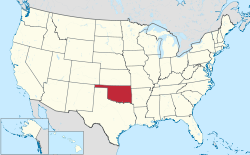 | |
| Number of elections | 30 |
|---|---|
| Voted Democratic | 10 |
| Voted Republican | 20 |
| Voted other | 0 |
| Voted for winning candidate | 21 |
| Voted for losing candidate | 9 |
Oklahoma is a state in the South Central region of the United States. [1] Since it joined the United States in 1907, [2] Oklahoma has participated in 29 presidential elections. It was initially granted seven electoral votes, [3] gaining three following the 1910 census. [4] It was given an additional vote in the 1930 census, [5] which it later lost in the 1940 census. [5] The state's electoral votes were reduced to eight in the 1950 census [6] before returning to its original seven following the 2000 census. [7]
Contents
In the 1960 election, Republican candidates Richard Nixon and Henry C. Lodge won Oklahoma. [8] However, elector Henry D. Irwin decided to cast a faithless vote for Harry F. Byrd and Barry Goldwater. An amendment to the Constitution of Oklahoma had been passed earlier to allow political parties to select their own electors. However, the amendment did not go effect until 1964. In 1961, the state passed a law that would invalidate any votes cast by and issue a fine to faithless electors. [9]
Oklahoma initially fluctuated between voting Democrat and Republican, but it has come to be considered a safely red state. Republicans have won every single county in Oklahoma since the 2004 presidential election. [10] The last Democrat to win the state was Lyndon B. Johnson in his 1964 landslide victory. [11] [12] Oklahoma was last considered a swing state during the presidential campaigns of Southern Democratic Governors of Jimmy Carter (1976 and 1980) and Bill Clinton (1992 and 1996). [13]
Republicans have won the White House without winning Oklahoma only twice: William Howard Taft in 1908 and Calvin Coolidge in 1924. Democrats have won without the state seven times, most recently in Joe Biden's victory in 2020.